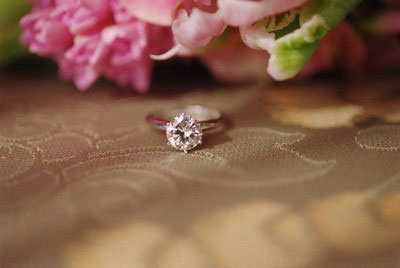By
Reuters
Reuters
Published
Jun 10, 2009
Jun 10, 2009
Diamond engagement rings lose sparkle in Japan
By
Reuters
Reuters
Published
Jun 10, 2009
Jun 10, 2009
By Nathan Layne
TOKYO (Reuters) - To 29-year-old Tsutomu Tada and his bride-to-be, an expensive diamond ring just seemed like a waste of money, especially in these tough economic times.
 |
"If economically I was in a really comfortable position I guess I would buy a ring," said Tada, a Japanese employee at a radio station in Tokyo. "But I'd rather put that money toward giving us a fuller life once we get married."
Japanese men are increasingly spending less on diamond engagement rings or not buying them at all, a reflection of the country's sluggish economy and changing views on courtship and marriage.
The trend underscores the challenges facing Western brands like Tiffany (TIF.N) and Bulgari (BULG.MI), which dominate a bridal jewelry market that has shrunk by a third over the past 15 years and is now worth $2 billion.
"It should worry a lot of European jewelers," said Yannick Derrien, general manager of the Japan operations of France's Mauboussin, which earlier this year opened a store on the main jewelry strip in the Ginza district of Tokyo.
When Japan's economy was booming in the 1970s and 1980s men were encouraged to spend the equivalent of three months salary after a commercial from diamond producer De Beers that took root in the public consciousness.
That commercial started to look out of touch with reality after the country's economic bubble popped in the early 1990s and Japan entered the "lost decade" of stop-start growth. It last aired in 1997 after a 20-year run.
Yano Research Institute estimates the average diamond engagement ring purchased this year will cost 290,070 yen, down from 387,000 yen in 1993 and roughly the equivalent of one month of salary for an entry level white collar job.
Over the same period the percentage of men that bought a ring will have slipped to half from nearly 80 percent.
Experts say the drop-off stems partly from a decline in the practice of "yuino," a tradition of betrothal gifts between families. The engagement ring is sometimes included in the package of gifts from the groom.
"In the past when it was a marriage of two families, an entire family would get behind the giving of yuino gifts," said Rieko Ohsaki, an editor at wedding magazine Zexy.
"In the sense that it is now a marriage of two people, it becomes whatever those two people can afford."
SILVER LINING
Demographically there is little reason for optimism.
The number of marriages peaked above 1 million a year in the early 1970s before entering a long downtrend. It has recently settled at around 700,000 a year but will likely fall in coming years as the population shrinks and greys.
Couples are spending more on wedding bands while some are buying watches and other jewelry items in lieu of engagement rings. But overall the pie is still shrinking.
Traditional jewelers are also having to cope with new market entrants like GNH, which is selling rings online, similar to the strategy of Blue Nile (NILE.O) in the U.S.
That means tougher competition for a customer base that will become increasingly discerning about quality and price.
Last week more than 5,000 people lined up outside the Mauboussin store in Ginza to receive a voucher for a 0.1 carat loose diamond worth about $50. The French jeweler is now trying to translate that campaign into sales of pendants and rings.
"The outlook remains tough. The population is declining and the number of people buying engagement rings should continue to fall," said Chiharu Akiyoshi, a senior researcher at Yano.
"Luxury brands are making efforts to strengthen their presence in bridal jewelry because it is holding up relatively well to the economic slump."
Some jewelers are expanding their product offerings to target both the cost-conscious and the well-to-do.
De Beers Diamond Jewelers Japan, a joint venture between De Beers and luxury group LVMH (LVMH.PA), said it was enjoying double-digit sales growth of bridal jewelry, helped by a wider range of models including a 0.3 carat ring for 210,000 yen.
"We have broadened our product range and have been able to capture demand," said Yoriko Daijima, a public relations director at the company, which sells De Beers products in Japan.
And in a sign jewelers can still move the really big stones, a De Beers store in Ginza recently sold a 2 carat ring for about $100,000.
The catch? - The buyer wasn't Japanese.
© Thomson Reuters 2024 All rights reserved.

























